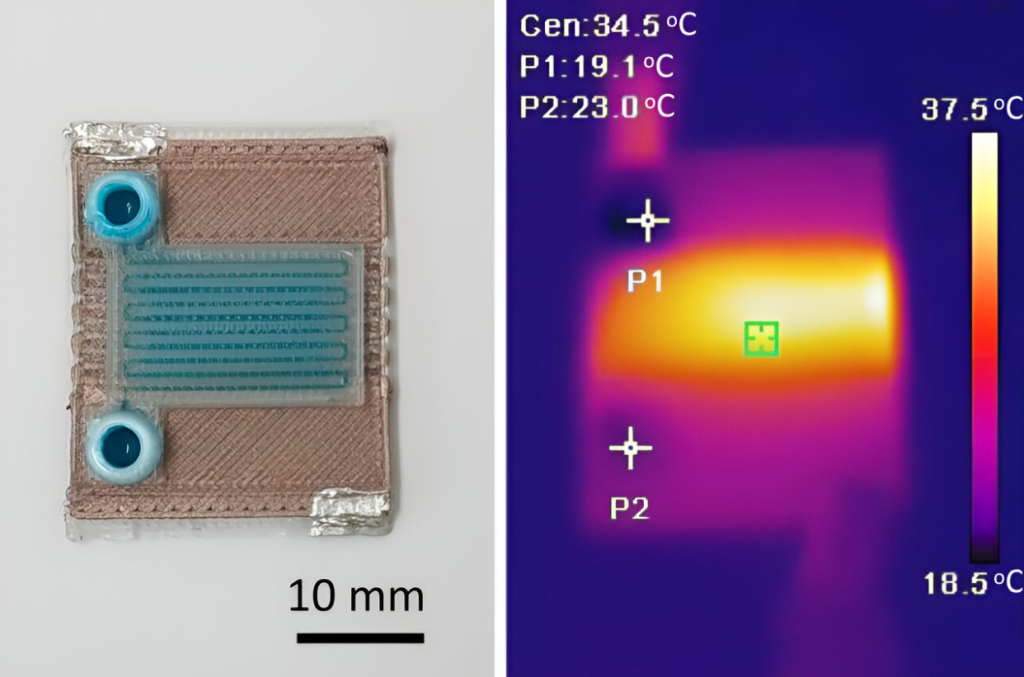Massachusetts Institute of Technology (MIT) researchers have developed 3D printed self-heating microfluidic devices, offering potential applications in affordable disease detection tools.
MIT’s research team adopted multimaterial 3D printing, a cost-effective method, to create self-heating microfluidic devices in a single manufacturing step. This technique allows for customization, enabling engineers to design microfluidic devices with specific heating profiles or temperatures in designated areas. Requiring approximately $2 worth of materials, the low-cost fabrication process holds potential for use in remote regions of developing countries where access to expensive lab equipment is limited.
“Clean rooms in particular, where you would usually make these devices, are incredibly expensive to build and to run. But we can make very capable self-heating microfluidic devices using additive manufacturing, and they can be made a lot faster and cheaper than with these traditional methods. This is really a way to democratize this technology,” says Luis Fernando Velásquez-García, a Principal Scientist in MIT’s Microsystems Technology Laboratories (MTL) and senior author of a paper describing the fabrication technique.

Self-heating microfluidic devices
The researchers utilized multi-material extrusion 3D printing, incorporating a biodegradable polymer (polylactic acid or PLA) and a modified version infused with copper nanoparticles. When transformed into a resistor, this modified PLA becomes conductive, allowing the dissipation of electrical current as heat. The result is a self-heating microfluidic device produced in a single step on a 3D printer.
“It is amazing when you think about it because the PLA material is a dielectric, but when you put in these nanoparticle impurities, it completely changes the physical properties. This is something we don’t fully understand yet, but it happens and it is repeatable,” added Velásquez-García.
To address challenges related to heat transfer and fluid leakage, the researchers added a thin, continuous layer of PLA between the resistor and microfluidic channels. Approximately the size of a U.S. quarter, the resulting device features channels 500 mm wide and 400 mm tall facilitating fluid flow and chemical reactions. Additionally, the team utilized a one-step manufacturing process to create a prototype capable of heating fluid by 4°C as it flowed between the input and the output. This customizable technique opens possibilities for creating devices that heat fluids in specific patterns or along designated gradients, showcasing the technology’s adaptability in diverse applications.
Despite the success of the prototype, limitations exist, such as the PLA’s maximum temperature of around 50°C, hindering applications requiring higher temperatures. The team aims to integrate a third material for temperature sensing and explore the use of printed magnets for particle sorting or alignment. While the simplicity of the proposed 3D printed microfluidic systems has garnered attention, further research is needed to address existing limitations and refine the capabilities of this technology for practical applications.
Medical 3D printing research from MIT has previously made headlines. Last year in March, MIT researchers developed a method for 3D printing soft replicas of patients’ hearts to mimic their unique blood-pumping capabilities. Transforming medical images into 3D computer models, the team uses polymer-based ink to print precise, flexible structures of patients’ hearts.
Sleeves around the 3D printed hearts and aortas simulated pumping actions, allowing researchers to tune the outflowing air for rhythmic pumping. Leveraging scans from 15 patients with aortic stenosis, the method involved converting their medical scans into 3D computer models, showcasing its potential for creating personalized heart models for treatment evaluation.
Microfluidics improving point-of-care
The integration of 3D printed microfluidics in point-of-care settings has the potential to transform diagnostics. With rapid prototyping and low-cost production, 3D printing allows tailored devices to address specific diagnostic needs. As 3D printing advances, it holds promise in enhancing accessible point-of-care diagnostics.
In the past, University of Bristol researchers introduced an affordable and open-source 3D printing method for creating microfluidic devices, specifically using PolyDimethylSiloxane (PDMS). Leveraging standard domestic equipment and a desktop 3D printer, it lowers costs and boosts accessibility in microfluidics research. The approach holds potential for affordable point-of-care diagnostic technology, impacting fields such as laboratories-on-a-chip, cell biology, and protein crystallization.
Elsewhere, Stevens Institute of Technology researchers employed computational modeling to advance microfluidics-based 3D bioprinting, aiming for the fabrication of entire human organs. Unlike extrusion-based bioprinters, their microfluidics approach precisely manipulates liquids through tiny channels, enabling structures as small as tens of microns.
In this case, cellular-scale precision was crucial for mimicking biological features accurately. The team sees microfluidics as a key factor in overcoming the technological limitations of current 3D bioprinting, potentially revolutionizing organ transplants by engineering complex tissues and even skin directly onto wounds.
What does the future of 3D printing for the next ten years hold?
What engineering challenges will need to be tackled in the additive manufacturing sector in the coming decade?
To stay up to date with the latest 3D printing news, don’t forget to subscribe to the 3D Printing Industry newsletter or follow us on Twitter, or like our page on Facebook.
While you’re here, why not subscribe to our Youtube channel? Featuring discussion, debriefs, video shorts, and webinar replays.
Are you looking for a job in the additive manufacturing industry? Visit 3D Printing Jobs for a selection of roles in the industry.
Featured image shows MIT researchers developed a fabrication process to produce self-heating microfluidic devices in one step using a multi-material 3D printer. Pictured is an example of one of the devices. Photo via Massachusetts Institute of Technology.



